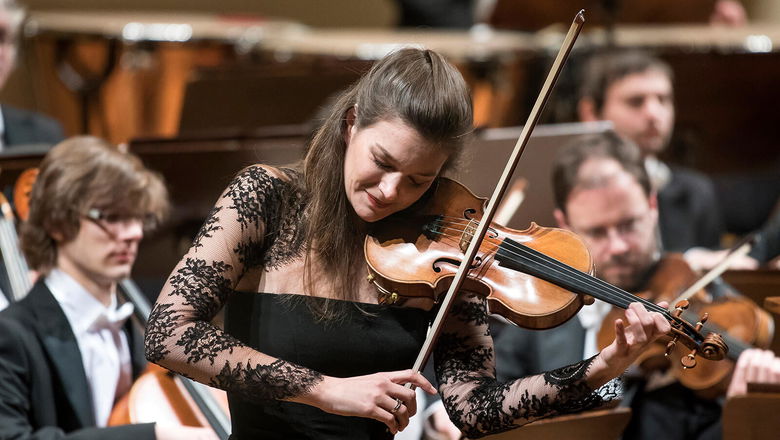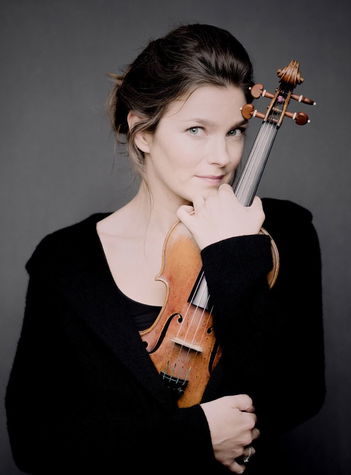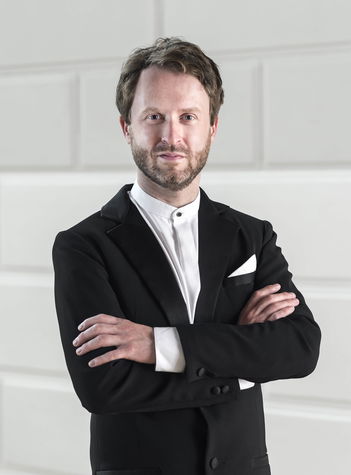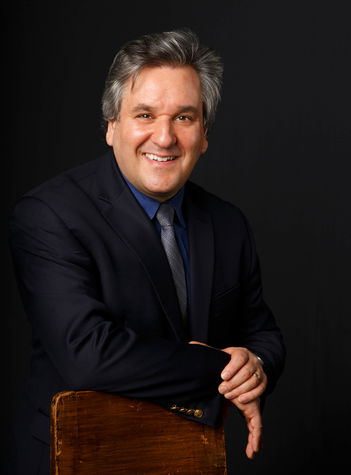Programme
Johannes Brahms
Nänie for mixed choir and orchestra, Op. 82 (14')
Felix Mendelssohn-Bartholdy
Violin Concerto in E minor, Op. 64 (26')
— Intermission —
Antonín Dvořák
Slavonic Dances, Op. 72 (35')
Secure your seat for the 2025/2026 season – presales are open.
Choose SubscriptionConcerts on the occasion of the national holiday commemorating the anniversary of the Velvet Revolution have become a tradition and a challenge for the selection of programmes and for the inviting of truly special guests. This year’s guests are Antonio Pappano and Janine Jansen.
The recommended dress code is black tie optional.
Duration of the programme 1 hour 35 minutes
Johannes Brahms
Nänie for mixed choir and orchestra, Op. 82 (14')
Felix Mendelssohn-Bartholdy
Violin Concerto in E minor, Op. 64 (26')
— Intermission —
Antonín Dvořák
Slavonic Dances, Op. 72 (35')
Janine Jansen violin
Prague Philharmonic Choir
Lukáš Vasilek choirmaster
Antonio Pappano conductor
Czech Philharmonic

Dear listeners,
the recommended dress code for this evening is black tie optional.
CHANGE OF START OF CONCERTS
The concerts on 16 and 17 November start at 20.00.
Thank you for your understanding.
Janine Jansen violin

Janine Jansen was born to a Dutch family. Her father, an organist, pianist, and harpsichord player, and her mother, a singer, taught music to all their children from an early age. Little Janine sang in the church choir and began playing the violin at age six under the guidance of the famed pedagogue Coosje Wijzenbeek and making music with her father and brothers. “There was no escaping music at home; life without it was unthinkable,” she recalls. She also witnessed the rehearsals of early music ensembles because some of the biggest names in the field of historically informed interpretation in those days were among her family’s friends, and that had such an influence on her that there was even a time when she played with a Baroque bow and gut strings. Ultimately, however, she decided to go the “traditional” route and to pay her respects to historically informed interpretation in other ways (like by the style of her phrasing), and that gives her playing a personal touch.
She made her debut at Amsterdam’s famed Concertgebouw at age 15, and even the sudden death of Philippe Hirschhorn, her teacher at the time, could not stop her rise to fame. Another teacher, Boris Belkin, followed, and shortly after her 20th birthday, she launched her international career and began making recordings on the Decca Classics label. Since her Vivaldi recording, which broke sales records, she has become famous all around the world.
For years now, top musical ensembles have been vying for her attention. In March 2024 at the Concertgebouw in Amsterdam, the inaugural Janine Jansen Bach Festival will take place, at which the violin superstar will play roles in planning the programmes and performing. Besides the traditional repertoire, this season also features contemporary music including the double concerto Distans by the English composer Sally Beamish and the world premiere of a violin concerto by Britta Byström. There is also plenty of touring squeezed into her busy schedule. The longest tour is to the Far East with the Oslo Philharmonic and Klaus Mäkelä, but there will be plenty of appearances in Europe as well. One tour includes an appearance with the London Symphony Orchestra led by Sir Antonio Pappano, with whom she has a long history of professional friendship.
Under his baton, Janine Jansen has make recordings including works by Brahms and Bartók, but they came into even closer contact when she made her latest CD titled “12 Stradivari”, a recording that the journal Gramophone even called “a beautiful testament to her very special musical friendship with Pappano”. Jansen came up with the truly original idea of creating a kind of study of twelve Stradivarius violins, presenting them in the repertoire for which those instruments were the inspiration, the goal being to let the outstanding qualities of each instrument come to the fore. And she invited none other than her “old friend” Pappano to accompany her at the piano.
Besides Pappano, Jansen also works closely with the pianist Denis Kozhukhin, with whom she will be appearing in December at Wigmore Hall as the season’s artist-in-residence, and she is playing in a trio established with Martha Argerich and Mischa Maisky. She already got a taste of chamber music at home as a child, and her teacher Coosje Wijzenbeek strongly fostered that interest. Chamber music has had an indispensable place in her career, as is also shown by the International Chamber Music Festival Utrecht, which has been under her artistic supervision from its founding until what is now its 20th season.
Prague Philharmonic Choir
The Prague Philharmonic Choir (PPC), founded in 1935 by the choirmaster Jan Kühn, is the oldest professional mixed choir in the Czech Republic. Their current choirmaster and artistic director is Lukáš Vasilek, and the second choirmaster is Lukáš Kozubík.
The choir has earned the highest acclaim in the oratorio and cantata repertoire, performing with the world’s most famous orchestras. In this country, they collaborate regularly with the Czech Philharmonic and the Prague Philharmonia. They also perform opera as the choir-in-residence of the opera festival in Bregenz, Austria.
Programmes focusing mainly on difficult, lesser-known works of the choral repertoire. For voice students, they are organising the Academy of Choral Singing, and for young children there is a cycle of educational concerts.
The choir has been honoured with the 2018 Classic Prague Award and the 2022 Antonín Dvořák Prize.
Lukáš Vasilek choirmaster

Lukáš Vasilek studied conducting and musicology. Since 2007, he has been the chief choirmaster of the Prague Philharmonic Choir (PPC). Most of his artistic work with the choir consists of rehearsing and performing the a cappella repertoire and preparing the choir to perform in large-scale cantatas, oratorios, and operatic projects, during which he collaborates with world-famous conductors and orchestras (such as the Berlin Philharmonic, the Czech Philharmonic, the Israel Philharmonic, and the Saint Petersburg Philharmonic).
Besides leading the PPC, he also engages in other artistic activities, especially in collaboration with the vocal ensemble Martinů Voices, which he founded in 2010. As a conductor or choirmaster, his name appears on a large number of recordings that the PPC have made for important international labels (Decca Classics, Supraphon); in recent years, he has been devoting himself systematically to the recording of Bohuslav Martinů’s choral music. His recordings have received extraordinary acclaim abroad and have earned honours including awards from the prestigious journals Gramophone, BBC Music Magazine, and Diapason.
Antonio Pappano conductor

The standing of Sir Antonio Pappano, a conductor adorned by multiple honours and awards, including the Order of Merit of the Italian Republic, the Order of the British Empire and the Gold Medal of the Royal Philharmonic Society, is perhaps best illustrated by his current situation. This season, after more than two decades, he will leave the post of music director of the world-renowned Royal Opera House in London (to be succeeded by the Czech conductor Jakub Hrůša) and assume the role of chief conductor of the prestigious London Symphony Orchestra. Can one rise any higher?
One of the presently most sought-after opera and concert conductors, Sir Antonio Pappano was born in 1959 in Epping, Essex, into a family who had moved to England from Italy. When he was 13 years of age, they relocated to Connecticut. The son of a distinguished voice teacher, he did not attend any music school, taking private lessons instead. After completing his training in piano (with Norma Verrilli), composition (with Arnold Franchetti) and conducting (with Gustav Meier), Sir Antonio worked as a pianist and rehearsal accompanist at opera houses in Europe and the USA. While at the Lyric Opera of Chicago, he attracted the attention of maestro Daniel Barenboim, who would name the gifted young artist his assistant. Following his first conducting experience, in Oslo, at the age of 31 Sir Antonio was appointed music director of Den Norske Opera. He served as music director of the Théâtre Royal de la Monnaie in Brussels, principal guest conductor of the Israel Philharmonic Orchestra and music director of the Orchestra dellʼAccademia Nazionale di Santa Cecilia in Rome.
In 2019, he and the Orchestra dellʼAccademia Nazionale di Santa Cecilia appeared to great acclaim at the Prague Spring festival, and last season he performed in the subscription concerts of the Czech Philharmonic.
Sir Antonio Pappano’s wide-ranging discography primarily includes opera albums, yet he has also made numerous recordings of symphonic music, mostly by Romantic composers, as well as other works, with the Orchestra dell’Accademia Nazionale di Santa Cecilia, the London Symphony Orchestra, the Berliner Philharmoniker and other feted orchestras. Since 1995, Sir Antonio has extensively recorded for Warner Classics.
Besides the Royal Opera House in London, where he has conducted productions of operas ranging from Baroque to contemporary, Sir Antonio Pappano has recently appeared at the Metropolitan Opera in New York, the Wiener Staatsoper, the Staatsoper Berlin and Milan’s La Scala, as well as at the Bayreuther Festspiele.
Johannes Brahms
Nänie for mixed choir and orchestra, Op. 82
Johannes Brahms took inspiration for several of his works from subject matter referring to the cultural treasures of antiquity. In ancient Rome, a “naenia” was a song of lament that accompanied a funeral procession. The poem Nänie by Friedrich Schiller (1759–1805) was published in 1800, and Johannes Brahms wrote a musical setting for mixed choir and orchestra 80 years later in reaction to the death of his friend, the painter Anselm Feuerbach (1829–1880), and dedicated it to the artist’s mother Henrietta Feuerbach. Schiller’s verses are a lament for abstract beauty; the dead hero is not identified in the poem, nor is the ruler of the underworld mentioned by name. Knowledge of mythology was widespread in those days, and readers recognised the combining of several motifs – the familiar Orpheus and Euridice motif, Aphrodite weeping over her dead lover Adonis, the inability of the sea nymph Thetis to save the life of her son, the Trojan War hero Achilles, and her grief, which the gods of Olympus shared with her.
The composition’s three formal sections make plentiful use of tone painting corresponding to the poem’s structure. After an orchestral introduction, the first section mourns the death of beauty (the central idea is entrusted to a solo soprano). The second part describes the inexorability of death. The lament of the sea nymph Thetis constitutes the third part of the composition. The premiere took place on 6 December 1881 at the Tonhalle in Zurich with Brahms conducting a programme consisting exclusively of his own works, including the Second Piano Concerto, in which he also appeared as the soloist, the Tragic Overture, and the First Symphony. More performances of Nänie soon followed in Dresden, Hamburg, Frankfurt, London, and elsewhere.
Felix Mendelssohn Bartholdy
Violin Concerto in E minor, Op. 64
Felix Mendelssohn Bartholdy composed eight works for one or more solo instrument and orchestra, but the only ones to find a lasting place in the repertoire have been his two piano concertos (G minor and D minor) and especially the Violin Concerto in E minor, Op. 64, the composer’s second work in the violin concerto genre. The first of his violin concertos, the work of a prodigy just 13 years of age, was not performed until 1952 in a revision by Yehudi Menuhin, and it remains a kind of musical curiosity. By contrast, the Violin Concerto in E minor, Op. 64 is not only one of Mendelssohn’s most frequently performed works, but also a staple of the concerto repertoire all around the world. Mendelssohn wrote it for his friend, the violinist Ferdinand David (1810–1873), with whom he consulted on the playability of certain passages and debated over the role of virtuosity in the piece. A second advisor was the composer Niels Gade (1817–1890), in whose opinions Mendelssohn placed great trust.
The concerto is in three movements all linked together into a single whole. Instead of the usual double exposition (one orchestral and one with the solo instrument), the first movement opens with the violin playing already by the second bar. Another unusual feature is the cadenza, which comes not at the very end of the movement, but instead after the development section, forming a sophisticated transition to the final section of the sonata-allegro movement: as the brilliant solo part continues, the orchestra launches into the recapitulation. After a presto coda comes the direct, melodic lyricism of the slow movement. The finale, also attached without a pause, is in rondo form. Mendelssohn spent nearly six years working on the concerto, which was finished in September 1844. It was first heard on 13 March 1845 in Leipzig with Ferdinand David as the soloist. Mendelssohn heard his concerto again at the Gewandhaus just a month before his death at the opening concert of the season on 3 October 1847. The performer was Joseph Joachim, then just 16 years old, and Mendelssohn predicted a great future for the talented youth.
Antonín Dvořák
Slavonic Dances, Op. 72
It was at the recommendation of Johannes Brahms that in 1878 the Berlin publisher Fritz Simrock printed the cycle of Moravian Duets by Antonín Dvořák. Because of the success of the new work, the publisher commissioned another composition, this time a cycle of dances. Simrock was readily taking advantage of the trendy popularity of folk influences and of the characteristically “exotic” quality exhibited by the melodies and rhythms of various ethnic groups including the Slavs. Dvořák’s Moravian Duets had been published thanks to Johannes Brahms’s recommendation, and Simrock wanted the Czech composer’s new cycle to be “something in the manner of Brahms’s Hungarian Dances”. Dvořák reacted to this suggestion on 24 March 1878, informing Brahms: “Honoured Master! [...] I have been entrusted with writing some Slavonic dances for Mr Simrock, but because I did not know how to begin, I tried to get my hands on your famous Hungarian Dances, and I am taking the liberty of using them as a model for working on corresponding Slavonic Dances.” That same year (1878), he wrote his first series of eight Slavonic Dances, Op. 46, originally intended (like Brahms’s cycle) for piano four-hands. The first series was a huge success, and the Berlin publisher requested a continuation. This time, however, Dvořák hesitated initially: “Doing the same thing twice is damned hard,” he complained to Simrock. In the end, however, he did find inspiration for a second series, which also contains eight dances, and as was the case with the first series, the version for piano four-hands appeared simultaneously with an orchestral version.
Besides Czech dances, the second series of Slavonic Dances, Op. 72 (1886) covers a wider range of Slavic territory, with the dances including the odzemek of Moravian Silesia, the Ukrainian dumka, the Polish polonaise, and the Serbian kolo. Dvořák did not quote folk melodies directly in any of the dances, however. These masterful stylisations of characteristic elements are pure Dvořák and entirely unique, and although the individual dances are identifiable, Dvořák did not assign them titles, providing only tempo indications. Three dances of the second series (nos. 1, 2, and 7) were first heard at a concert on 6 January 1887 at the Rudolfinum under the composer’s baton.
Concerts on the occasion of the national holiday commemorating the anniversary of the Velvet Revolution have become a tradition and a challenge for the selection of programmes and for the inviting of truly special guests. This year’s guests are Antonio Pappano and Janine Jansen.
The recommended dress code is black tie optional.